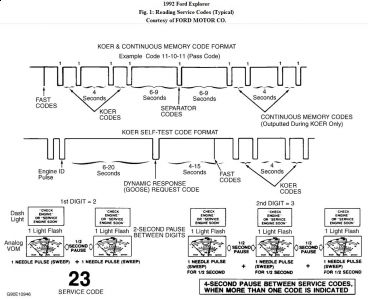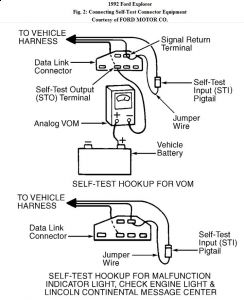If you have a VOM ( Analog Volt Meter), you can retrieve the trouble code. Let me know what you find.
READING CODES
KOEO & KOER SELF -TEST CODES
All service codes are 2 or 3 -digit numbers. ECA outputs codes one digit at a time. These codes indicate current faults in system and should be serviced in order of appearance. Use SERVICE CODE REFERENCE CHARTS to find correct CIRCUIT TEST.
Codes are shown as voltage pulses. If using CHECK ENGINE light, service codes are displayed as light pulses. If using Volt-Ohmmeter (VOM), service codes are displayed as needle sweeps. See Fig. 1 .
Pay careful attention to length of pauses in order to read codes correctly. A 1/2 - second pause occurs between number of sweeps in a digit and a 2 - second pause occurs between digits in a code. A 4 - second pause occurs between each code. KOEO codes are separated from Continuous Memory Codes by a 6 - second delay, a single 1/2 - second sweep (Separator) and another 6 - second delay. Record codes in order received.
Scan tester, if used, will count pulses and display them as a digital code. STAR Series Tester will add a zero (0) to single-digit Separator Code (10) and Dynamic Response Code (10). Dynamic Response Code is displayed in KOER SELF -TEST. See Fig. 1 .
SEPARATOR CODE
Single 1/2 - second separator pulse is issued 6 - 9 seconds after last KOEO code. Continuous Memory Codes (soft faults) are then displayed 6 -9 seconds after 1/2 - second separator code. Some digital test equipment may display separator code as "10" instead of "1".
PASS CODES
Code 11 or 111 indicates system passes that portion of test. If Code 11 or 111 is not retrieved in KOEO SELF - TEST, codes retrieved during KOER SELF -TEST may not be valid. Code 11 - 1 - 11 or 111 - 1 - 111, output during KOEO SELF -TEST, indicates no KOEO code or Continuous Memory Code was recorded.
CONTINUOUS MEMORY CODES
Continuous Memory Codes are displayed after separator pulse code in KOEO SELF -TEST. These codes result from information stored by ECA during continuous self -test monitoring. These codes indicate faults recorded within last 40 engine starts (80 engine starts on some models). Fault may or may not be currently present. See SERVICE CODE REFERENCE CHARTS . Use these codes for diagnosis only when KOEO SELF -TEST and KOER SELF - TEST result in Code 11 or 111.
FAST CODES
At start of KOEO SELF - TEST and after Wide Open Throttle (WOT) request in KOER SELF - TEST, ECA outputs short bursts of information, known as FAST CODES, which were used by manufacturer during assembly. With most equipment, these code bursts are not visible; an entire code sequence lasts less than 1/2 second. If this fluctuation is visible on test equipment, ignore it.

VISUAL CHECK & EQUIPMENT HOOKUP
Ensure vacuum hoses and EEC -IV wiring harnesses are properly connected.
Apply parking brake, and place shift lever in PARK (A/T) or NEUTRAL (M/T) position. Block drive wheels. Turn off all electrical loads. Connect Analog Volt-Ohmmeter (VOM) to vehicle as follows:
1 . Turn ignition switch to OFF position. Set VOM at 0 - 15V DC range. Connect positive lead of VOM to positive battery terminal.
2 . Connect negative VOM lead to Self -Test Output (STO) terminal of self -test connector. See Fig. 2 . Connect jumper wire from Self - Test Input (STI) pigtail to signal return terminal of self -test connector, (located at right front inner fender panel). KOEO SELF -TEST will activate when ignition is turned on.

With coolant losses and overheating problems, there is a possibility of compression losses and a and head gasket even though water is not present in the engine oil. A compression test would be required to find out if it is anything to do with the engine internals.
Saturday, December 5th, 2009 AT 12:20 PM

